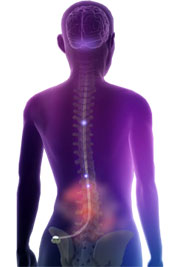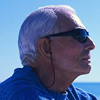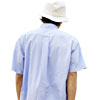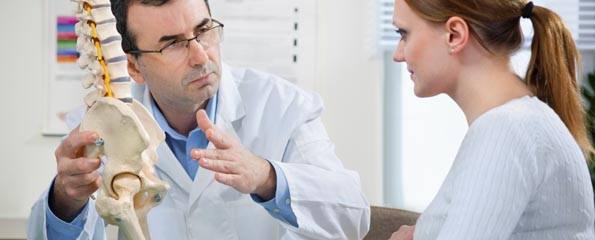Spinal cord stimulation (SCS) devices
- Overview of spinal cord stimulation
- Electrodes
- Leads
- Neuromodulator
- Programmer
- Current research and future aims
Overview of spinal cord stimulation (SCS)
 Spinal cord stimulation (SCS) is an emerging, minimally invasive procedure used to treat chronic, refractory, neuropathic pain. Neuropathic pain is one of the most difficult medical conditions to treat; it is not the “normal” pain we associate with stubbing a toe or getting a paper cut – this is nocioceptive pain. Neuropathic pain is caused by abnormal nerve signalling in the nervous system and, as a result, commonly does not respond to most pain relief strategies. It is for this reason that SCS is a very exciting area of development and is becoming widely accepted for use in many areas of neuropathic pain management. SCS does not eliminate pain but creates a numbness called paraesthesia in the area. This results in a masking of the pain.
Spinal cord stimulation (SCS) is an emerging, minimally invasive procedure used to treat chronic, refractory, neuropathic pain. Neuropathic pain is one of the most difficult medical conditions to treat; it is not the “normal” pain we associate with stubbing a toe or getting a paper cut – this is nocioceptive pain. Neuropathic pain is caused by abnormal nerve signalling in the nervous system and, as a result, commonly does not respond to most pain relief strategies. It is for this reason that SCS is a very exciting area of development and is becoming widely accepted for use in many areas of neuropathic pain management. SCS does not eliminate pain but creates a numbness called paraesthesia in the area. This results in a masking of the pain.
SCS involves implanting electrodes into the epidural space near the source of pain. Different levels of the spinal cord innervate different areas of the body. For example, the nerves that supply the fingers exit the central nervous system at one level of the spinal cord, and the nerves that supply the toes exit at a different level. Therefore if the pain is experienced in the chest area, the electrodes will be placed at the level of the spinal cord where the nerves emerge to innervate the chest. The electrodes are connected to wires or leads threaded through the epidural space. The leads transmit the electric current that stimulates the pain inhibition pathways; this is powered by an external or internal source, known as the neuromodulator. The power is supplied in pulses that are adjusted to suit the individual’s paraesthetic needs.
Devices used in SCS include:
- Electrodes;
- Leads;
- Neuromodulator; and
- Programmer.
 | For a general overview on SCS, including more information on the mechanisms behind paraesthesia, and the indications, costs, advantages, risks and contraindications of SCS, see Spinal Cord Stimulation. |
Electrodes
SCS evokes paraesthesia by transmitting electric pulses through connecting leads to the electrodes. The electrodes are implanted in the epidural space at the level of the spinal cord, which innervates the area where the pain is experienced.
The number of electrodes used is determined by the level and complexity of the pain experienced. A more widespread, higher degree of pain requires more electrodes to be placed in the epidural space. More electrodes placed in the spinal cord provides more paraesthesia options, because not all electrodes are stimulated at all times.
The electrode stimulation pattern is controlled externally and each pattern will induce a slightly different sensation, some of which will provide more pain relief than others. If more electrodes are available, the number of pattern combinations that can be tested is increased. In order to expand these stimulation options further, a multi-array of electrodes is situated at the ends of the leads; usually this comprises of 4, 8 or 16 electrode contacts.
Leads
The leads are responsible for transmitting the electrical pulses generated by the neuromodulator to the electrodes, which are located at the end of the leads. The leads are thin wires inserted via a needle into the epidural space.
The surgically implantable leads have a paddle-shaped electrode multi-array attached to the end, making them comparatively large compared to others available. Paddles provide an extensive coverage of the area and are used for more severe pain.
Percutaneous leads have a slimmer design than paddle leads, which allows them to be easily manipulated and controlled. These leads are best for pain that is unusually dispersed and therefore requires more unusual overlap of paraesthesia benefits. Percutaneous leads are cheaper, faster and easier to insert and remove. For these reasons, these leads are commonly used for the trial period between electrode placement and generator implantation, although they carry a greater risk of infection and lead migration.
Percutaneous leads consume more battery power than paddle leads, and therefore require more frequent battery replacements or recharging.
Neuromodulator
The neuromodulator is the power source of the stimulator system. It can be either internally implanted, acting as a generator; or remain external, with transmission occurring via a radiofrequency system coupled to an internally implanted receiver. The neuromodulator produces the electric currents that are then transmitted to the spinal cord. All systems can control up to 16 electrodes per lead, giving rise to many stimulating patterns.
The choice of neuromodulator is entirely dependent on the individual’s requirements and preferences. The predominant concerns dictating the choice are:
- The need for controllability of the system; and
- The need for substantial power deliverability to stimulate adequate stimulation.
Convenience, financial and cosmetic factors for the individual are also taken into account.
The radiofrequency system operates by sending radio waves in pulses to the implanted receiver. As radiofrequency systems are not dependent on internal battery activation and require more power than other systems, they work best for people with high stimulation requirements and the most complex and intense pain. This is because when the stimulatory needs are greater, the battery will need to be replaced more frequently. Radiofrequency systems are powered by an external transmitter, which carries the battery, and is therefore easily replaced without invasive surgery.
The radiofrequency system is not as aesthetically pleasing as a fully implanted device, as an antenna and transmitter must be worn externally. In addition, the antenna can cause irritation.
Implantable pulse generators (IPGs) are powered by an internal battery and must be replaced once it runs out. Recent developments have improved the size and battery life of IPGs.
Primary cell IPGs are similar to conventional implantable neuromodulators. They are suited to people who cannot operate a rechargeable system or do not require one. The batteries are high powered and have a life of up to 10 years, depending on use. The IPG can be implanted 2.5 cm under the skin. When the battery does need to be removed, it is a very minor procedure.
Rechargeable implantable pulse generator
The smallest neuromodulator currently available (10 mm wide and weighing less than 30 g) is a completely rechargeable implantable pulse generator, allowing the device to be used for a longer period. This means less invasive operations and a greater cost benefit. With a greater battery life, there is no need for major concern about conserving power on a day to day basis, and people implanted with this system should feel as though they can use the device as much as required. The remaining battery life is monitored by a controller. When the controller displays indicates low battery, the system needs to be recharged.
The device is completely implanted under the skin at a depth of about 2.5 cm. The battery is recharged via an externally controlled radiofrequency system. How often the battery must be recharged depends on use. Eventually, a point will be reached when the battery life per recharge will not last long enough for routine activities. It will then need to be surgically replaced.
Rechargable IPGs provide an alternative option for people with energy needs too high for the primary cell IPG, and whose only option in the past was radiofrequency systems. Substantial power requirements are still best served by radiofrequency.
Programmer
The programmer provides a non-invasive way of adjusting the stimulator settings, or turning off the system completely. For some people, the effects of the stimulation can last for up to a week after the power is shut down.
When the system is turned on, the programmer allows electrode activation and pulse parameters to be selected. The pulse parameters are the timing between pulses, and the length of each pulse delivered to the electrodes. There will be a range of pulse parameters that can induce an adequate level of pain relief for each person.
The initial pulse parameter limits are set up by the doctor. Subsequently, the pulse parameters can be controlled and adjusted on a day to day basis by the person implanted with the system. The limits are put in place for safety, so the parameters cannot accidently be set too high or too low when not supervised by the doctor.
In the past, the settings on programmers were adjusted manually by the doctor, allowing only a small number of possible combinations to be trialled due to the relatively slow process of manual adjustment and limited time spent with the doctor. This has changed recently with increased research and development into the area. Programming is becoming more consumer interactive with the use of automated controls. This automated system allows the safe exploration of a larger array of contact combinations without supervision from the doctor.
Current research and future aims
The devices involved in SCS are continuously being improved, and as devices and implantation procedures become more technologically advanced, the treatment becomes even more cost effective and quality of life for those who receive SCS improves. Current research in the area is focused on further improving the effect of stimulation and expanding its compatibility to allow a broader range of people to be eligible for the treatment. Future aims include:
- Increasing the number of contacts for each lead in order to better provide paraesthesia in the area;
- Designing the devices so they are compatible with MRI;
- Improving wireless options for control of the devices, for example through Bluetooth; and
- Improving lead delivery procedures in order to better target the spinal cord.
More information
 | For more information about SCS, the conditions treated with SCS, SCS devices, and some useful videos and news, see Spinal Cord Stimulation. |
Useful links
International Neuromodulation Society
St Jude Medical website
Chronic pain management and pain relief
 | The Power Over Your Pain website provides information about neurostimulation and helps you connect with others who are experiencing the benefits of the treatment. www.poweroveryourpain.com |
Articles related to this device include:
- Spinal cord stimulation in the treatment for angina pectoris
- Adding spinal cord stimulation to treatment plan gives best results for FBSS pain
- Chronic pain: A better understanding leads to better treatment possibilities
- 3rd Annual Meeting of the Australian Chapter of International Neuromodulation Society
- Spinal cord stimulation and acute pain processing
- An update on spinal cord stimulation
- 8th World Congress & 11th Annual Meeting of the International Neuromodulation Society
- Spinal cord stimulation: Benefiting neuropathic pain patients
- Spinal treatment useful for painful syndrome in children?
- Spinal cord stimulation a promising treatment for chronic pain disorders
- The changing face of neuromodulation
References
- North R, Shipley J, Prager J, et al. Practice parameters for the use of spinal cord stimulation in the treatment of chronic neuropathic pain. Pain Med. 2007;8(Suppl 4):S200-75. [Abstract]
- Spinal cord stimulation [online]. Plano, Texas: St Jude Medical; 2009 [cited 25 August 2009]. Available from: URL link
- Bala MM, Riemsma RP, Nixon J, Kleijnen J. Systematic review of the (cost-)effectiveness of spinal cord stimulation for people with failed back surgery syndrome. Clin J Pain. 2008;24(9):741-56. [Abstract]
- North RB, Calkins SK, Campbell DS, et al. Automated, patient-interactive, spinal cord stimulator adjustment: A randomized controlled trial. Neurosurgery. 2003;52(3):572-80. [Abstract]
- Tripole paddle leads [online]. Plano, Texas: St Jude Medical; 2009 [cited 25 August 2009]. Available from: URL link
- Kreis PG, Fishman SM, Chau K. Impact to spinal cord stimulator lead integrity with direct suture loop ties. Pain Med. 2009;10(3):495-500. [Abstract]
- North NB, Wetzel FT. Spinal cord stimulation for chronic pain of spinal origin: A valuable long-term solution. Spine. 2002;27(22):2584-91. [Abstract]
- Percutaneous leads [online]. Plano, Texas: St Jude Medical; 2009 [cited 25 August 2009]. Available from: URL link
- EonC primary cell IPG system [online].Plano, Texas: St Jude Medical; 2009 [cited 25 August 2009]. Available from: URL link
- Genesis primary cell IPG system [online]. Plano, Texas: St Jude Medical; 2009 [cited 25 August 2009]. Available from: URL link
- Eon rechargable IPG system [online]. Plano, Texas: St Jude Medical; 2009 [cited 25 August 2009]. Available from: URL link
- Eon Mini rechargable IPG system [online]. Plano, Texas: St Jude Medical; 2009 [cited 25 August 2009]. Available from: URL link
- NeuroDynamix [online]. Plano, Texas: St Jude Medical; 2009 [cited 25 August 2009]. Available from: URL link
- Rapid programmer (R) 3.0 [online]. Plano, Texas: St Jude Medical; 2009 [cited 25 August 2009]. Available from: URL link
- Mekhail NA, Cheng J, Narouze S, et al. Clinical applications of neurostimulation: Forty years later. Pain Pract. 2010;10(2):103-12. [Abstract]
Dates
Tags
Created by:

 Login
Login














